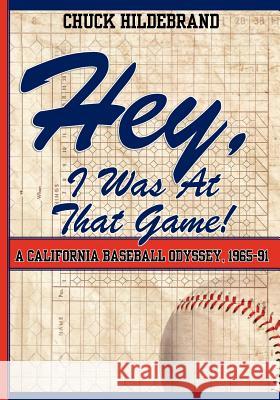Hey, I Was At That Game! A California Baseball Odyssey, 1965-91 » książka
Hey, I Was At That Game! A California Baseball Odyssey, 1965-91
ISBN-13: 9781460986561 / Angielski / Miękka / 2011 / 532 str.
Chuck Hildebrand's "Hey, I Was At That Game A California Baseball Odyssey, 1965-91" is built around the scorebooks kept by the author as he explored and experienced every layer of baseball in America's most populous state - first as a young minor league fan and later as a journalist covering major league baseball during its Bay Area apex. It is a diary originally transcribed in baseball's first language, created by Henry Chadwick when he invented the baseball box score in 1859, and it is a chronology written from the same standpoint as Roger Angell's classic baseball anthologies, but seen through a uniquely California prism. "Hey, I Was At That Game A California Baseball Odyssey, 1965-91" includes first-hand descriptions of some of baseball's most transcendent moments, such as Kirk Gibson's home run to win Game 1 of the 1988 World Series, and the Loma Prieta earthquake that halted the 1989 World Series. It also includes a first-person remembrance of the pitcher who in 1973 completed the only perfect game in the history of the California League, and an account of the game in 1975 in which Lee Mazzilli of the Visalia Mets stole seven bases in a seven-inning game - a feat never accomplished or matched in professional baseball. The author covered three major league World Series, but he also covered a College World Series and a Little League World Series. He also coached at a high amateur level, and his frame of reference is alternately the press box, the clubhouse, the seats and the dugout. Readers will get a sense of baseball as seen from all those perspectives, and more. At its essence, the book is a view of the places, especially in Northern California, where baseball once was nurtured at its embryonic stages. The vantage point sometimes is the press box or a seat at Candlestick Park or the Oakland Coliseum. More often, it is a wooden or metal bench at a dimly-lit, bucolic minor league or college ballpark from which conversations between batters and home-plate umpires were clearly audible, where the baseball was precise but the ambiance was informal and personal. More than 1,000 games are recorded in the author's scorebooks, involving some players who are in the Hall of Fame, and many more whose moments in baseball time exist only in a few memories - and now, in this book. The book also is a remembrance of a time before the baseball experience was homogenized and orchestrated, when small cities had baseball teams because it was good for the cities, not for their owners' profit margins, when the outcome mattered but the baseball itself mattered much more. The reader will meet, or remember, personalities and performances and places that transcended their surroundings, and contributed in their own way to the texture of baseball as it was played and watched during a less formal and ordered era. "Hey, I Was At That Game A California Baseball Odyssey, 1965-91" will introduce readers to prominent players as they were before they became prominent, and to obscure players who never were household names or even played in the majors, but remain couriers of baseball's heritage and standards, decades after the end of their playing careers. It will also include baseball at its wackiest, at places like Sacramento's Hughes Stadium, where home runs - 14 in one game seen by the author - made scorebook pages look as if they were interpreted by Andy Warhol. While "Hey, I Was At That Game A California Baseball Odyssey, 1965-91" is a book about baseball, it is also a book about writing about baseball. It details a baseball adolescence that lasted deep into adulthood, and a newspaper career that paralleled the ascent, decline and fall of an industry. The career, the baseball adolescence, and the book's main narrative halt in 1991, but in the epilogue, they flourish anew.
Zawartość książki może nie spełniać oczekiwań – reklamacje nie obejmują treści, która mogła nie być redakcyjnie ani merytorycznie opracowana.











